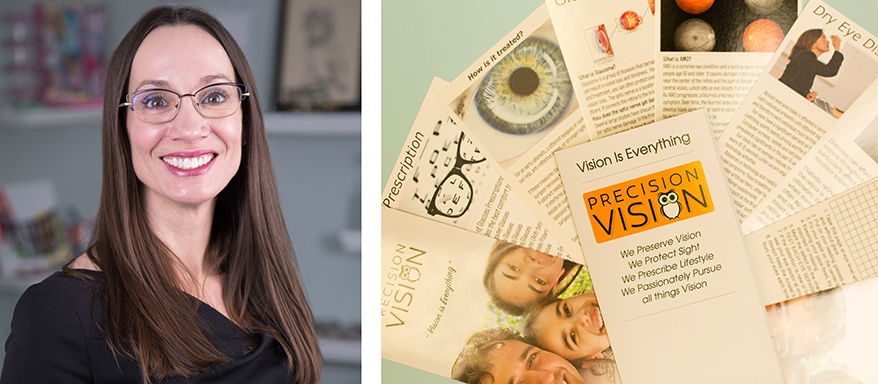REACHING OUT TO ECPS on the subject of patient questionnaires, we sensed that while almost everyone finds them useful, there is a tendency to downplay them for fear of being seen as lacking a personal touch. So, fully acknowledging that handing someone a form to fill out is no substitute for taking a genuine interest, we hope this month’s Benchmarks will serve as a reminder that the written word has its place in patient care, whether it’s for purposes of gleaning information, helping to educate patients, extracting the type of information that some people just can’t verbalize, or simply reinforcing the notion that you’re concerned and here to help as best you can, and not just looking to sell something.

Precision Vision of Edmond Edmond, OK
Dr. Selina McGee uses the information gleaned from her patient questionnaire to customize prescriptions, especially desktop/workspace glasses and sunglasses. “I ask every patient to ‘walk me through their typical day.’” A follow-up question asks about any frustrations they encounter performing daily activities. “This reveals how they use their vision and really helps me…minimize their pain points.” Recommendations could include blue light protection, anti-glare, UV protection, or contact lenses. “These simple questions give me a wealth of knowledge and instead of ‘selling’ something to the patient, I’m identifying and prescribing what I can do to help them utilize their vision to the fullest extent.”
Educating patients is a priority for McGee, so “these questions easily allow me to flow into those important messages too.”
Customized rack cards go in all patients’ passport folders so that they have more educational items to read at home as well.

Vision Trends Dover, OH
Despite years of experience, Dr. Scott Keating still learns things when scanning the answers to his patient questionnaires. There are some things, it seems, patients will only put down in writing. “I was especially surprised at the answers to the second question on how patients’ contact lenses feel at the end of the day. The patients could rate the comfort on a scale of 1 to 10. About 30 percent marked a 4-6 range and yet never brought the comfort issue up in the pre-exam work with the staff.” It was as if discomfort was just considered normal by patients when wearing contact lenses, he discovered. “This simple questionnaire has made a big change for me in the exam room,” Keating adds.
Whereas he used to assume they were happy with their current brand because there were no complaints in the check-in process, now he routinely asks patients who rate their end-of-day comfort level below an 8 if they would like to try another brand. “I can tell the patient is happy that I suggested a change. I almost feel like some patients are afraid to tell the staff and especially the doctor.”
Advertisement


Attleboro Vision Care Attleboro, MA
Optician Christine Howard found that a tool devised to help her understand patients and their needs was having an interesting reverse effect: It was helping to shape patients’ views of the practice in a positive way. “We began using the lifestyle questionnaire to get to know our patients’ visual needs a bit better,” explains Howard. “It’s fairly simple and straightforward, asking questions like what patients do/don’t like about their current glasses, what visual demands/stresses they encounter on a daily basis, and what their hobbies are. By having this information, it helps us tailor a lens for the patient that’s going to work best for them based on their unique life [experience].”
But the learning experience was a two-way street, she recalls. “We began using this because it makes it a more personal experience and it helps us be seen as problem solvers instead of option sellers,” Howard says.


Falls City Eye Care Louisville, KY
At Falls City Eye Care, the survey is given orally, but it’s still a standardized set of questions. According to Dr. Michael Martorana, “it’s a series of basically hand-picked questions from our Revolution EHR data gathering and personal history.” The survey is heavy on computer use and hobbies, and Martorana finds it useful to bring up computer AR, technology lenses, and daily contact lens wear. “There is a section regarding computer use frequency and hours per day, as well as any correlation with computer use and ocular fatigue or discomfort. We also ask about how many eye drops per day they use and any issues with redness, itching, tearing or blurred vision.”
Martorana finds asking these questions gives him the ability to not only reveal possible dry eye issues that the patient may be experiencing, “but also allows the patient to realize that these symptoms aren’t normal and they don’t have to live with them.”